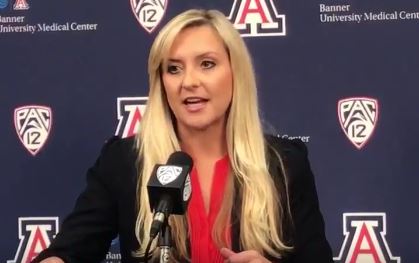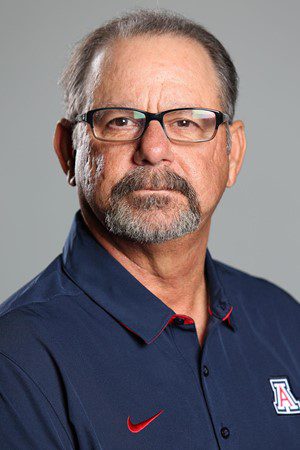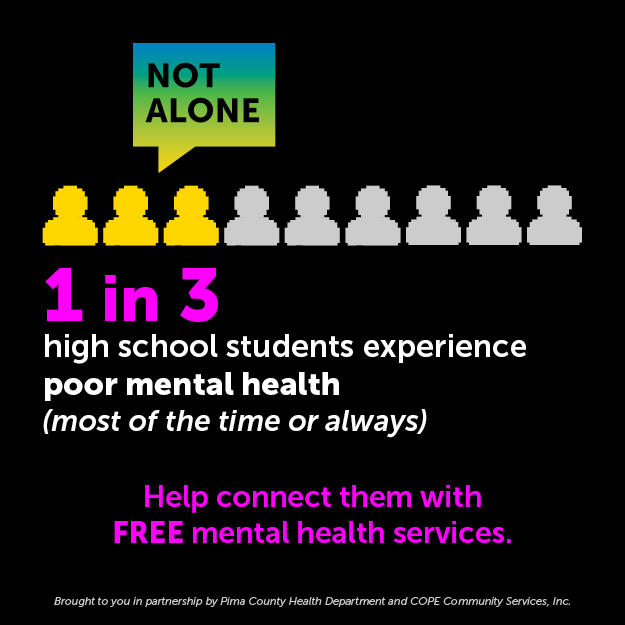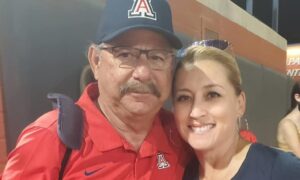It’s been a month since Greg Byrne abruptly left to become the athletic director at Alabama. Since that time, UA president Ann Weaver Hart and her two appointed helpers — former UA AD Cedric Dempsey and former associate AD Rocky LaRose (great picks to help in the process) — have been combing the schools to 1) see who is available and 2) who might want to follow become the third AD since Dempsey left.

Erika Barnes
Erika Barnes has filled the position in the interim but there has been talk — in circles that are not public enough or big enough to gain steam — that she could be the right candidate for the job. Last month in discussing the job she said she was unsure if she’d pursue it and it’s not clear if that has changed. So, we will see. She’s just a bit younger than Byrne was when he took over at Arizona. He was 38.
Here are a couple of other names with ties to UA: Mike Candrea, who has been here more than 30 years and knows the system, culture and is well-liked by everyone. He certainly has the chops for it. Would he rather do that than coach? My guess is probably not, even with the big pay raise. But, hey, it’s a thought if UA wants to stay with a local guy who won’t break the bank.

Mike Candrea
Or how about the esteemed Frank Busch, the former UA swim coach who just retired from USA Swimming, effective in September. Bring him on — maybe in a role that would help bridge the gap for a more-seasoned Barnes in, um, three or four years? Busch is well-respected, popular, knows the culture and climate of UA, knows the mindset of today’s student-athlete and can mingle with the alums who have money. Of course, there’s more to it than that, but he’s smart and can manage the day-to-day.

Frank Busch. USA Swimming photo
Just two names among the many that have been thrown out.
Spring Football set to begin
Football starts on Saturday for the annual spring workouts with Rich Rodriguez having to recover from what – by his standards as well as Arizona’s – was hardly acceptable. And there’s a lot of work to be done in the next few months before Arizona starts the 2017 season.
Already, he has to replace two popular assistants in receivers coach Tony Dews and Charlie Ragle. Dews left for West Virginia and Ragle to California. Can they be replaced? No question. By better coaches? Very likely. What’s strange is the timing of it all. Dews returned to his home area of West Virginia, while Ragle left his home area (Arizona-Southwest).
Maybe it’s just me, but it’s strange timing and a sign they believe that Arizona has to find a way to win this upcoming season … or else they would be looking for new jobs anyway. It’s a tough situation to be sure and an awkward one as well.

Arizona needs to get healthy and good in a hurry. Arizona fans – fickle as they are – don’t like watching mediocre football. And, in the end (if it ever happens) poor records lead to bad attendance, which leads to dismissed coaches.
Down the stretch they come
Arizona has five more regular season games left and then comes the Pac-12 Conference Tournament. The coming weeks – of the regular season – will make or break a seed or two for Arizona.
The facts are Arizona is a solid No. 3 seed as I type this with a chance to get to a No. 2 seed. Arizona must win out to have that happen, including in the Pac-12 tournament where it’ll be a mine-field in early March.
For years, Arizona coach Lute Olson denounced the tournament, saying 18 games of regular season play were enough to determine seeds and success. And for years the Pac-12 didn’t play a tournament. Then big money came in, tons of tickets have been sold (in Vegas not Los Angeles) and here we are.
Arizona still has a tough road in Washington this week (it should sweep but it hasn’t played well lately) and then UCLA and USC come visiting. Let’s say Arizona wins the rest of its regular-season games and loses in the Pac-12 tournament. It would still be a 2 or a 3. But timing of the loss is important. Arizona is clearly not a 4-seed, but has a lot of work to be a No. 1.

(Photo courtesy of Arizona Athletics)
Here’s a list of things the committee looks at when seeding the NCAA Tournament. BTW, for those who think the Associated Press rankings have anything to do with it, well, enjoy your island and those who think like you.
This from the NCAA:
The basic RPI consists of a team’s Division I winning percentage (25 percent weight), its opponents’ winning percentage (50 percent weight) and its opponents opponents’ winning percentage (25 percent weight). The RPI is one of many factors the committees use for selecting and seeding teams.
Other criteria the committee considers in the selections process are:
• An extensive season-long evaluation of teams through watching games, conference monitoring calls and regional advisory committee rankings;
• Complete box scores and results;
• Head-to-head results and results versus common opponents;
• Imbalanced conference schedules and results;
• Overall and non-conference strength of schedule;
• The quality of wins and losses;
• Road record;
• Player and coach availability; and
• Various computer metrics.
















